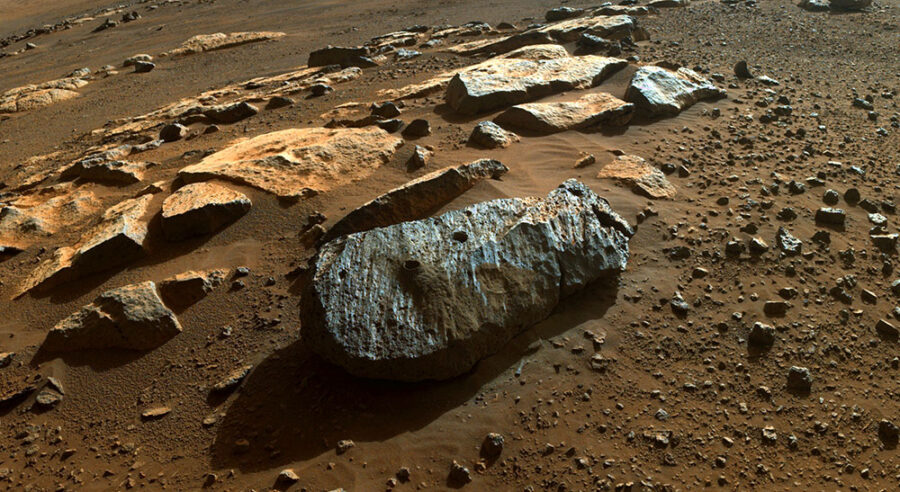After a rocky first start, Perseverance hit pay dirt on the second try. The rover collected two samples recording ancient volcanic eruptions and groundwater interaction.

NASA / JPL-Caltech
After a tense start to the sample collection campaign for NASA’s Perseverance rover on August 5th, researchers finally confirmed on September 6th that the rover has successfully collected two chalk-size cores from Jezero Crater on Mars. The holes were drilled September 1st and 7th, respectively.
“NASA has a history of setting ambitious goals and then accomplishing them, reflecting the nation’s commitment to discovery and innovation,” says NASA administrator Bill Nelson in a recent press release. “This is a momentous achievement and I can’t wait to see the incredible discoveries produced by Perseverance and our team.”
The sampling process began on September 1st, when the rover deployed the rotary-percussive drill on the end of its robotic arm to drill a core sample from the large rock dubbed “Rochette.” This boulder is part of a 1-kilometer (half-mile)-long ridgeline named “Artuby.”
I’ve got it! With better lighting down the sample tube, you can see the rock core I collected is still in there. Up next, I’ll process this sample and seal the tube. #SamplingMars
Latest images: https://t.co/Ex1QDo3eC2 pic.twitter.com/gumqpmoXBW
— NASA's Perseverance Mars Rover (@NASAPersevere) September 5, 2021
The Mastcam-Z camera documented the initial collection process, and preliminary success was announced on September 3rd.
However, mission controllers had to wait for a better sun angle to see deep inside the tube to ensure that the sample had really been collected. The team uses a “percuss to ingest” maneuver during collection, vibrating the tube and drill bit several times to clear the outer tube edge of residue in preparation for sealing. This can cause the collected material to slide further into the tube, out of the initial visibility of Mastcam-Z if the lighting isn’t favorable.
The process was suspenseful because Perseverance ran into problems on its first sampling sampling attempt in August, when a sampling run came up empty. Team members think that rock fragmented as the drill “rotary-percussed” into it. (The initial sample did, however, collect Martian atmosphere, so not all was lost.) That's why the team really wanted the images to confirm a successful run — and now, new images show the second attempt was indeed successful.

NASA / JPL-Caltech
The rover moved the first sample tube, with serial number 266, to the Sampling and Caching System, where it was measured, imaged, and hermetically sealed. A few days later, Perseverance drilled a second hole and stored it as well.
Based on preliminary analysis, scientists believe the rock cores are igneous, originating in ancient volcanic eruptions. The presence of salts in the rock indicate that water percolated through this rock long ago. Once the samples are returned to labs on Earth, scientists will look to see if these salts have trapped liquid bubbles, called inclusions; these could provide a glimpse of Jezero Crater when it was wet and possibly capable of supporting life.
With more than 3,000 moving parts, the caching system is one of the most complex mechanisms ever fielded on a rover or spacecraft. Perseverance has 43 sample tubes and five empty “witness tubes” used to gauge the baseline environment prior to collection. Ultimately, the team wants to collect about 30 samples throughout the mission.
“Getting the first sample under our belt is a huge milestone,” says Ken Farley (JPL-Caltech) in a recent press release. “When we get these samples back on Earth, they are going to tell us a great deal about some of the earliest chapters in the evolution of Mars.”
Martian Geology
Scientists think the exposed Artuby ridgeline that Perseverance is exploring contains exposed layers of ancient bedrock. The rover's first collection campaign will have it travel between 2.5 and 5 kilometers back to the original Octavia E. Butler landing site. It will collect samples of this ancient rock along the way, filling up to eight tubes.
From there, Perseverance will head to the northwest to another intriguing area: the fan-shaped delta, where an ancient river spilled into Jezero. This region should be rich in clay deposits.

NASA / JPL-Caltech
Unlike other landers and rovers, Perseverance is explicitly designed to be an astrobiology mission, and looks to specifically address the question of whether or not life once existed on Mars. Characterizing the past geology and climate of Jezero are key to that exploration.
Perseverance will eventually deposit the collected sample tubes for eventual pickup and Earth return by a future mission. Northrop Grumman is already contracted to build the propulsion system for the Mars ascent vehicle for Earth return, and the European Space Agency will collaborate with NASA for the sample return mission and in-depth analysis back on Earth sometime in the coming decade.
Congrats to the Perseverance team on a first successful sample collection, and many more to come!
 1
1









Comments
Lariliss
October 1, 2021 at 10:03 am
Great success for the robotic mission and technology proof on Mars. Also it is important as a composite mission, including depositing and handling samples on Mars as it is planned for the surface geological investigation. Looking forward to scientific discoveries. Precious data for astronauts for future Mars missions and geological planet's history investigation.
You must be logged in to post a comment.
You must be logged in to post a comment.